Analyzing Employee Motivation and Performance in Business Management
VerifiedAdded on 2020/12/10
|12
|2695
|383
Report
AI Summary
This report analyzes the impact of motivation on employee performance, drawing on three research articles. The first article investigates the relationship between intrinsic and extrinsic rewards, finding that intrinsic rewards and non-monetary rewards are key to employee motivation and commitment, particularly in South Africa. The second article examines employee motivation in the mining industry in Ghana, highlighting the importance of motivational strategies for retaining skilled human resources and ensuring safety. The third article explores the impact of self-efficacy on motivation and performance, emphasizing the role of training and development in enhancing employees' confidence and output. The report provides self-reflections on each article, offering insights into the practical implications of these concepts for business management and human resource strategies.
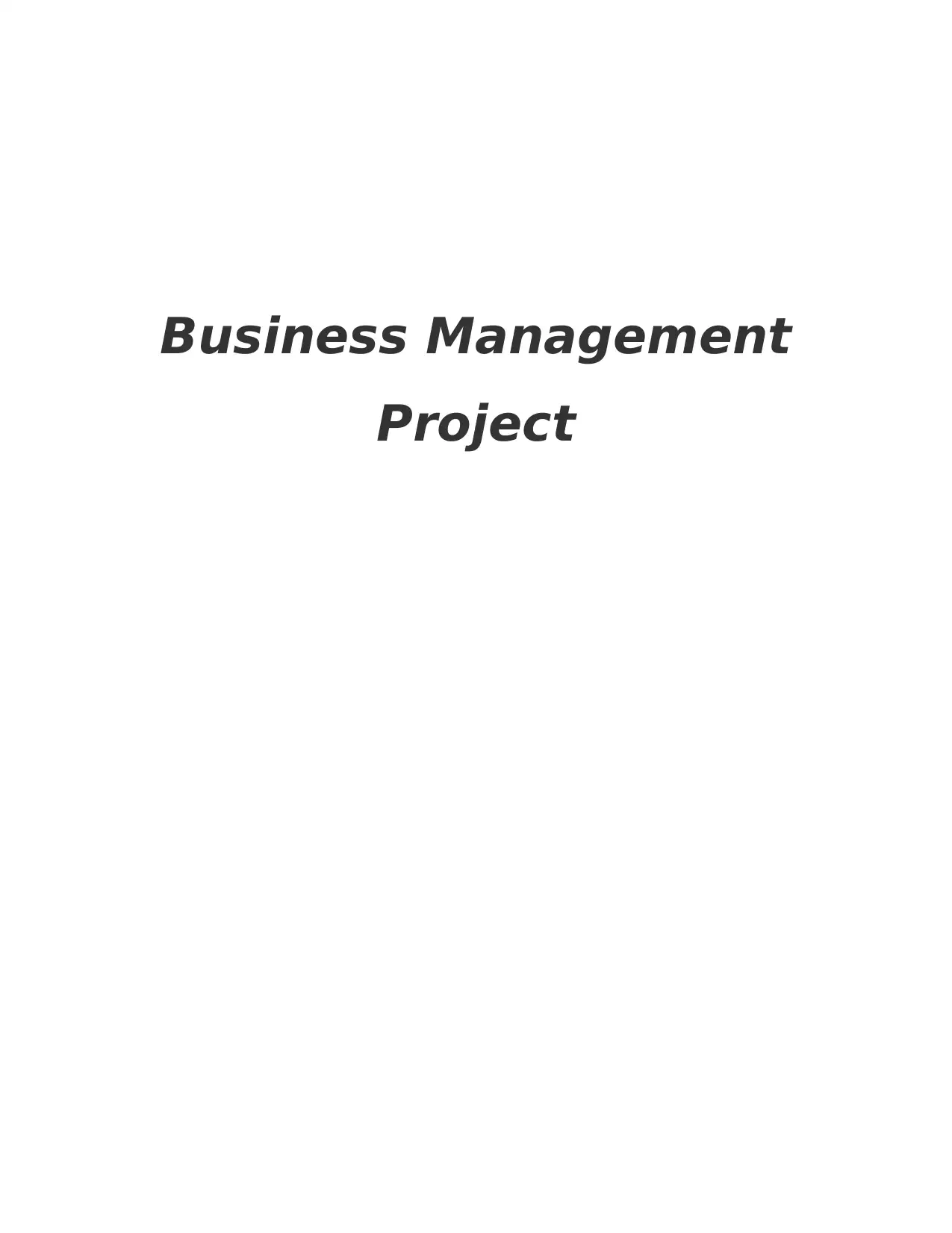
Business Management
Project
Project
Paraphrase This Document
Need a fresh take? Get an instant paraphrase of this document with our AI Paraphraser

Table of Contents
INTRODUCTION...........................................................................................................................1
Conclusion.......................................................................................................................................6
REFERENCES................................................................................................................................8
INTRODUCTION...........................................................................................................................1
Conclusion.......................................................................................................................................6
REFERENCES................................................................................................................................8
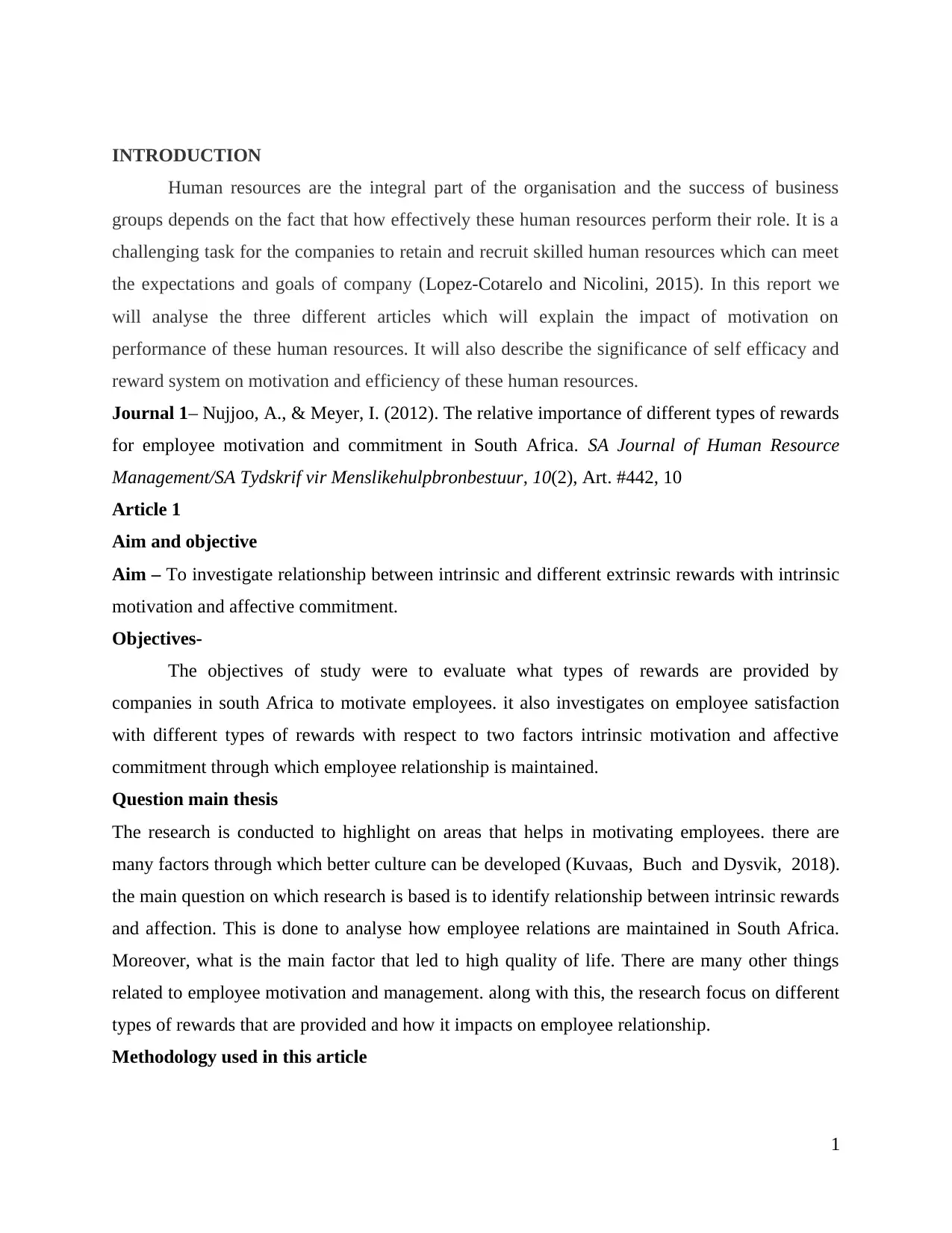
INTRODUCTION
Human resources are the integral part of the organisation and the success of business
groups depends on the fact that how effectively these human resources perform their role. It is a
challenging task for the companies to retain and recruit skilled human resources which can meet
the expectations and goals of company (Lopez-Cotarelo and Nicolini, 2015). In this report we
will analyse the three different articles which will explain the impact of motivation on
performance of these human resources. It will also describe the significance of self efficacy and
reward system on motivation and efficiency of these human resources.
Journal 1– Nujjoo, A., & Meyer, I. (2012). The relative importance of different types of rewards
for employee motivation and commitment in South Africa. SA Journal of Human Resource
Management/SA Tydskrif vir Menslikehulpbronbestuur, 10(2), Art. #442, 10
Article 1
Aim and objective
Aim – To investigate relationship between intrinsic and different extrinsic rewards with intrinsic
motivation and affective commitment.
Objectives-
The objectives of study were to evaluate what types of rewards are provided by
companies in south Africa to motivate employees. it also investigates on employee satisfaction
with different types of rewards with respect to two factors intrinsic motivation and affective
commitment through which employee relationship is maintained.
Question main thesis
The research is conducted to highlight on areas that helps in motivating employees. there are
many factors through which better culture can be developed (Kuvaas, Buch and Dysvik, 2018).
the main question on which research is based is to identify relationship between intrinsic rewards
and affection. This is done to analyse how employee relations are maintained in South Africa.
Moreover, what is the main factor that led to high quality of life. There are many other things
related to employee motivation and management. along with this, the research focus on different
types of rewards that are provided and how it impacts on employee relationship.
Methodology used in this article
1
Human resources are the integral part of the organisation and the success of business
groups depends on the fact that how effectively these human resources perform their role. It is a
challenging task for the companies to retain and recruit skilled human resources which can meet
the expectations and goals of company (Lopez-Cotarelo and Nicolini, 2015). In this report we
will analyse the three different articles which will explain the impact of motivation on
performance of these human resources. It will also describe the significance of self efficacy and
reward system on motivation and efficiency of these human resources.
Journal 1– Nujjoo, A., & Meyer, I. (2012). The relative importance of different types of rewards
for employee motivation and commitment in South Africa. SA Journal of Human Resource
Management/SA Tydskrif vir Menslikehulpbronbestuur, 10(2), Art. #442, 10
Article 1
Aim and objective
Aim – To investigate relationship between intrinsic and different extrinsic rewards with intrinsic
motivation and affective commitment.
Objectives-
The objectives of study were to evaluate what types of rewards are provided by
companies in south Africa to motivate employees. it also investigates on employee satisfaction
with different types of rewards with respect to two factors intrinsic motivation and affective
commitment through which employee relationship is maintained.
Question main thesis
The research is conducted to highlight on areas that helps in motivating employees. there are
many factors through which better culture can be developed (Kuvaas, Buch and Dysvik, 2018).
the main question on which research is based is to identify relationship between intrinsic rewards
and affection. This is done to analyse how employee relations are maintained in South Africa.
Moreover, what is the main factor that led to high quality of life. There are many other things
related to employee motivation and management. along with this, the research focus on different
types of rewards that are provided and how it impacts on employee relationship.
Methodology used in this article
1
⊘ This is a preview!⊘
Do you want full access?
Subscribe today to unlock all pages.

Trusted by 1+ million students worldwide
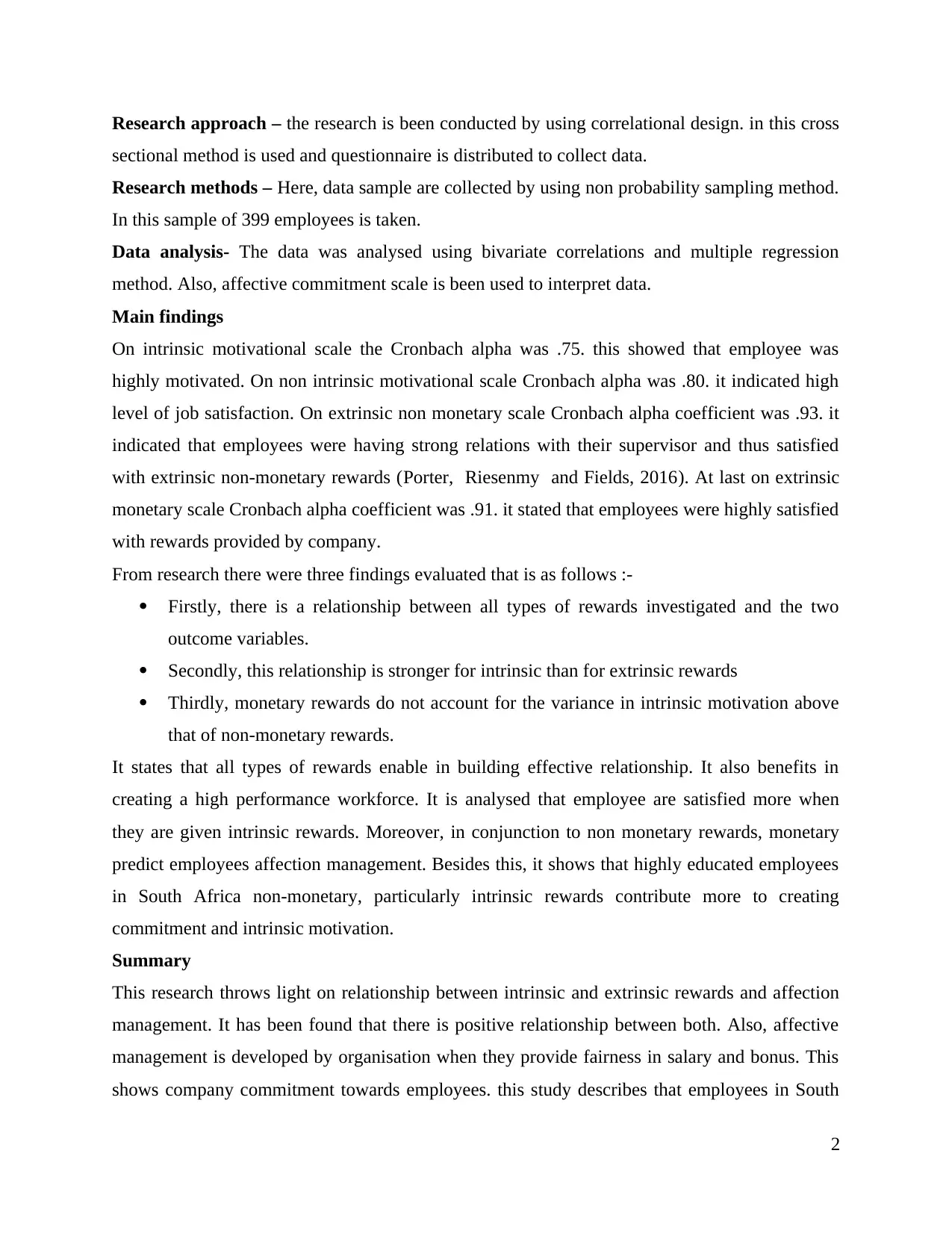
Research approach – the research is been conducted by using correlational design. in this cross
sectional method is used and questionnaire is distributed to collect data.
Research methods – Here, data sample are collected by using non probability sampling method.
In this sample of 399 employees is taken.
Data analysis- The data was analysed using bivariate correlations and multiple regression
method. Also, affective commitment scale is been used to interpret data.
Main findings
On intrinsic motivational scale the Cronbach alpha was .75. this showed that employee was
highly motivated. On non intrinsic motivational scale Cronbach alpha was .80. it indicated high
level of job satisfaction. On extrinsic non monetary scale Cronbach alpha coefficient was .93. it
indicated that employees were having strong relations with their supervisor and thus satisfied
with extrinsic non-monetary rewards (Porter, Riesenmy and Fields, 2016). At last on extrinsic
monetary scale Cronbach alpha coefficient was .91. it stated that employees were highly satisfied
with rewards provided by company.
From research there were three findings evaluated that is as follows :-
Firstly, there is a relationship between all types of rewards investigated and the two
outcome variables.
Secondly, this relationship is stronger for intrinsic than for extrinsic rewards
Thirdly, monetary rewards do not account for the variance in intrinsic motivation above
that of non-monetary rewards.
It states that all types of rewards enable in building effective relationship. It also benefits in
creating a high performance workforce. It is analysed that employee are satisfied more when
they are given intrinsic rewards. Moreover, in conjunction to non monetary rewards, monetary
predict employees affection management. Besides this, it shows that highly educated employees
in South Africa non-monetary, particularly intrinsic rewards contribute more to creating
commitment and intrinsic motivation.
Summary
This research throws light on relationship between intrinsic and extrinsic rewards and affection
management. It has been found that there is positive relationship between both. Also, affective
management is developed by organisation when they provide fairness in salary and bonus. This
shows company commitment towards employees. this study describes that employees in South
2
sectional method is used and questionnaire is distributed to collect data.
Research methods – Here, data sample are collected by using non probability sampling method.
In this sample of 399 employees is taken.
Data analysis- The data was analysed using bivariate correlations and multiple regression
method. Also, affective commitment scale is been used to interpret data.
Main findings
On intrinsic motivational scale the Cronbach alpha was .75. this showed that employee was
highly motivated. On non intrinsic motivational scale Cronbach alpha was .80. it indicated high
level of job satisfaction. On extrinsic non monetary scale Cronbach alpha coefficient was .93. it
indicated that employees were having strong relations with their supervisor and thus satisfied
with extrinsic non-monetary rewards (Porter, Riesenmy and Fields, 2016). At last on extrinsic
monetary scale Cronbach alpha coefficient was .91. it stated that employees were highly satisfied
with rewards provided by company.
From research there were three findings evaluated that is as follows :-
Firstly, there is a relationship between all types of rewards investigated and the two
outcome variables.
Secondly, this relationship is stronger for intrinsic than for extrinsic rewards
Thirdly, monetary rewards do not account for the variance in intrinsic motivation above
that of non-monetary rewards.
It states that all types of rewards enable in building effective relationship. It also benefits in
creating a high performance workforce. It is analysed that employee are satisfied more when
they are given intrinsic rewards. Moreover, in conjunction to non monetary rewards, monetary
predict employees affection management. Besides this, it shows that highly educated employees
in South Africa non-monetary, particularly intrinsic rewards contribute more to creating
commitment and intrinsic motivation.
Summary
This research throws light on relationship between intrinsic and extrinsic rewards and affection
management. It has been found that there is positive relationship between both. Also, affective
management is developed by organisation when they provide fairness in salary and bonus. This
shows company commitment towards employees. this study describes that employees in South
2
Paraphrase This Document
Need a fresh take? Get an instant paraphrase of this document with our AI Paraphraser
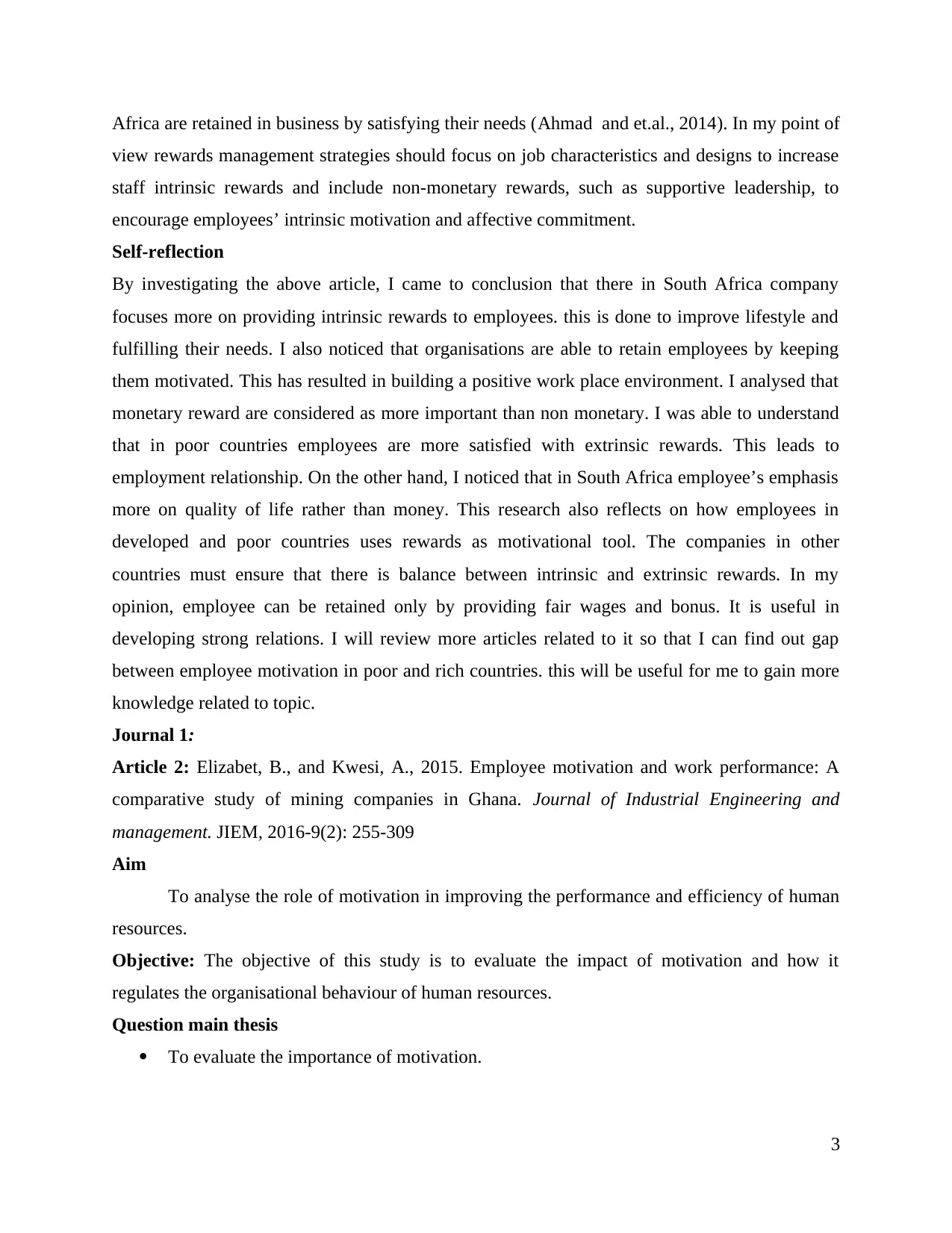
Africa are retained in business by satisfying their needs (Ahmad and et.al., 2014). In my point of
view rewards management strategies should focus on job characteristics and designs to increase
staff intrinsic rewards and include non-monetary rewards, such as supportive leadership, to
encourage employees’ intrinsic motivation and affective commitment.
Self-reflection
By investigating the above article, I came to conclusion that there in South Africa company
focuses more on providing intrinsic rewards to employees. this is done to improve lifestyle and
fulfilling their needs. I also noticed that organisations are able to retain employees by keeping
them motivated. This has resulted in building a positive work place environment. I analysed that
monetary reward are considered as more important than non monetary. I was able to understand
that in poor countries employees are more satisfied with extrinsic rewards. This leads to
employment relationship. On the other hand, I noticed that in South Africa employee’s emphasis
more on quality of life rather than money. This research also reflects on how employees in
developed and poor countries uses rewards as motivational tool. The companies in other
countries must ensure that there is balance between intrinsic and extrinsic rewards. In my
opinion, employee can be retained only by providing fair wages and bonus. It is useful in
developing strong relations. I will review more articles related to it so that I can find out gap
between employee motivation in poor and rich countries. this will be useful for me to gain more
knowledge related to topic.
Journal 1:
Article 2: Elizabet, B., and Kwesi, A., 2015. Employee motivation and work performance: A
comparative study of mining companies in Ghana. Journal of Industrial Engineering and
management. JIEM, 2016-9(2): 255-309
Aim
To analyse the role of motivation in improving the performance and efficiency of human
resources.
Objective: The objective of this study is to evaluate the impact of motivation and how it
regulates the organisational behaviour of human resources.
Question main thesis
To evaluate the importance of motivation.
3
view rewards management strategies should focus on job characteristics and designs to increase
staff intrinsic rewards and include non-monetary rewards, such as supportive leadership, to
encourage employees’ intrinsic motivation and affective commitment.
Self-reflection
By investigating the above article, I came to conclusion that there in South Africa company
focuses more on providing intrinsic rewards to employees. this is done to improve lifestyle and
fulfilling their needs. I also noticed that organisations are able to retain employees by keeping
them motivated. This has resulted in building a positive work place environment. I analysed that
monetary reward are considered as more important than non monetary. I was able to understand
that in poor countries employees are more satisfied with extrinsic rewards. This leads to
employment relationship. On the other hand, I noticed that in South Africa employee’s emphasis
more on quality of life rather than money. This research also reflects on how employees in
developed and poor countries uses rewards as motivational tool. The companies in other
countries must ensure that there is balance between intrinsic and extrinsic rewards. In my
opinion, employee can be retained only by providing fair wages and bonus. It is useful in
developing strong relations. I will review more articles related to it so that I can find out gap
between employee motivation in poor and rich countries. this will be useful for me to gain more
knowledge related to topic.
Journal 1:
Article 2: Elizabet, B., and Kwesi, A., 2015. Employee motivation and work performance: A
comparative study of mining companies in Ghana. Journal of Industrial Engineering and
management. JIEM, 2016-9(2): 255-309
Aim
To analyse the role of motivation in improving the performance and efficiency of human
resources.
Objective: The objective of this study is to evaluate the impact of motivation and how it
regulates the organisational behaviour of human resources.
Question main thesis
To evaluate the importance of motivation.
3
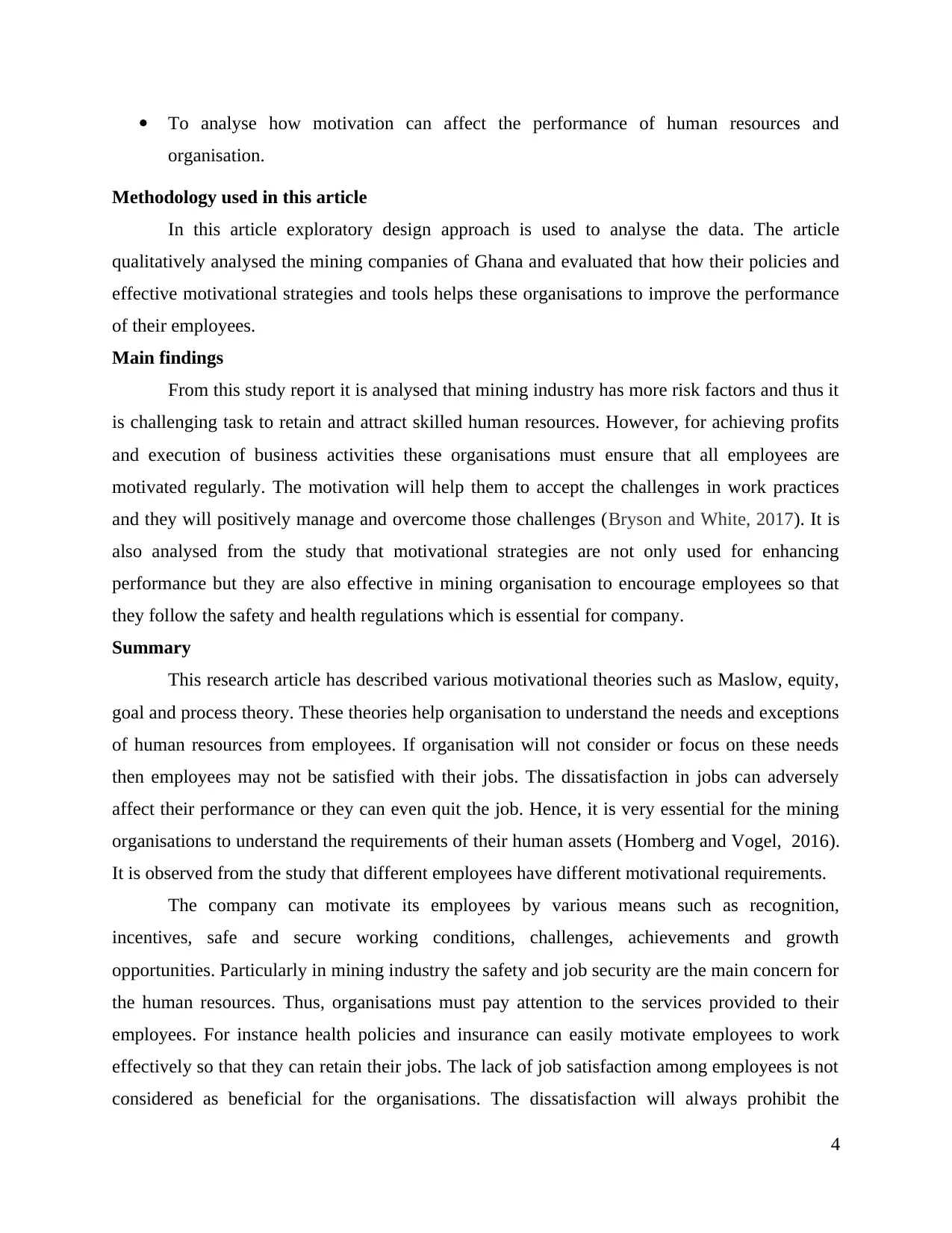
To analyse how motivation can affect the performance of human resources and
organisation.
Methodology used in this article
In this article exploratory design approach is used to analyse the data. The article
qualitatively analysed the mining companies of Ghana and evaluated that how their policies and
effective motivational strategies and tools helps these organisations to improve the performance
of their employees.
Main findings
From this study report it is analysed that mining industry has more risk factors and thus it
is challenging task to retain and attract skilled human resources. However, for achieving profits
and execution of business activities these organisations must ensure that all employees are
motivated regularly. The motivation will help them to accept the challenges in work practices
and they will positively manage and overcome those challenges (Bryson and White, 2017). It is
also analysed from the study that motivational strategies are not only used for enhancing
performance but they are also effective in mining organisation to encourage employees so that
they follow the safety and health regulations which is essential for company.
Summary
This research article has described various motivational theories such as Maslow, equity,
goal and process theory. These theories help organisation to understand the needs and exceptions
of human resources from employees. If organisation will not consider or focus on these needs
then employees may not be satisfied with their jobs. The dissatisfaction in jobs can adversely
affect their performance or they can even quit the job. Hence, it is very essential for the mining
organisations to understand the requirements of their human assets (Homberg and Vogel, 2016).
It is observed from the study that different employees have different motivational requirements.
The company can motivate its employees by various means such as recognition,
incentives, safe and secure working conditions, challenges, achievements and growth
opportunities. Particularly in mining industry the safety and job security are the main concern for
the human resources. Thus, organisations must pay attention to the services provided to their
employees. For instance health policies and insurance can easily motivate employees to work
effectively so that they can retain their jobs. The lack of job satisfaction among employees is not
considered as beneficial for the organisations. The dissatisfaction will always prohibit the
4
organisation.
Methodology used in this article
In this article exploratory design approach is used to analyse the data. The article
qualitatively analysed the mining companies of Ghana and evaluated that how their policies and
effective motivational strategies and tools helps these organisations to improve the performance
of their employees.
Main findings
From this study report it is analysed that mining industry has more risk factors and thus it
is challenging task to retain and attract skilled human resources. However, for achieving profits
and execution of business activities these organisations must ensure that all employees are
motivated regularly. The motivation will help them to accept the challenges in work practices
and they will positively manage and overcome those challenges (Bryson and White, 2017). It is
also analysed from the study that motivational strategies are not only used for enhancing
performance but they are also effective in mining organisation to encourage employees so that
they follow the safety and health regulations which is essential for company.
Summary
This research article has described various motivational theories such as Maslow, equity,
goal and process theory. These theories help organisation to understand the needs and exceptions
of human resources from employees. If organisation will not consider or focus on these needs
then employees may not be satisfied with their jobs. The dissatisfaction in jobs can adversely
affect their performance or they can even quit the job. Hence, it is very essential for the mining
organisations to understand the requirements of their human assets (Homberg and Vogel, 2016).
It is observed from the study that different employees have different motivational requirements.
The company can motivate its employees by various means such as recognition,
incentives, safe and secure working conditions, challenges, achievements and growth
opportunities. Particularly in mining industry the safety and job security are the main concern for
the human resources. Thus, organisations must pay attention to the services provided to their
employees. For instance health policies and insurance can easily motivate employees to work
effectively so that they can retain their jobs. The lack of job satisfaction among employees is not
considered as beneficial for the organisations. The dissatisfaction will always prohibit the
4
⊘ This is a preview!⊘
Do you want full access?
Subscribe today to unlock all pages.

Trusted by 1+ million students worldwide
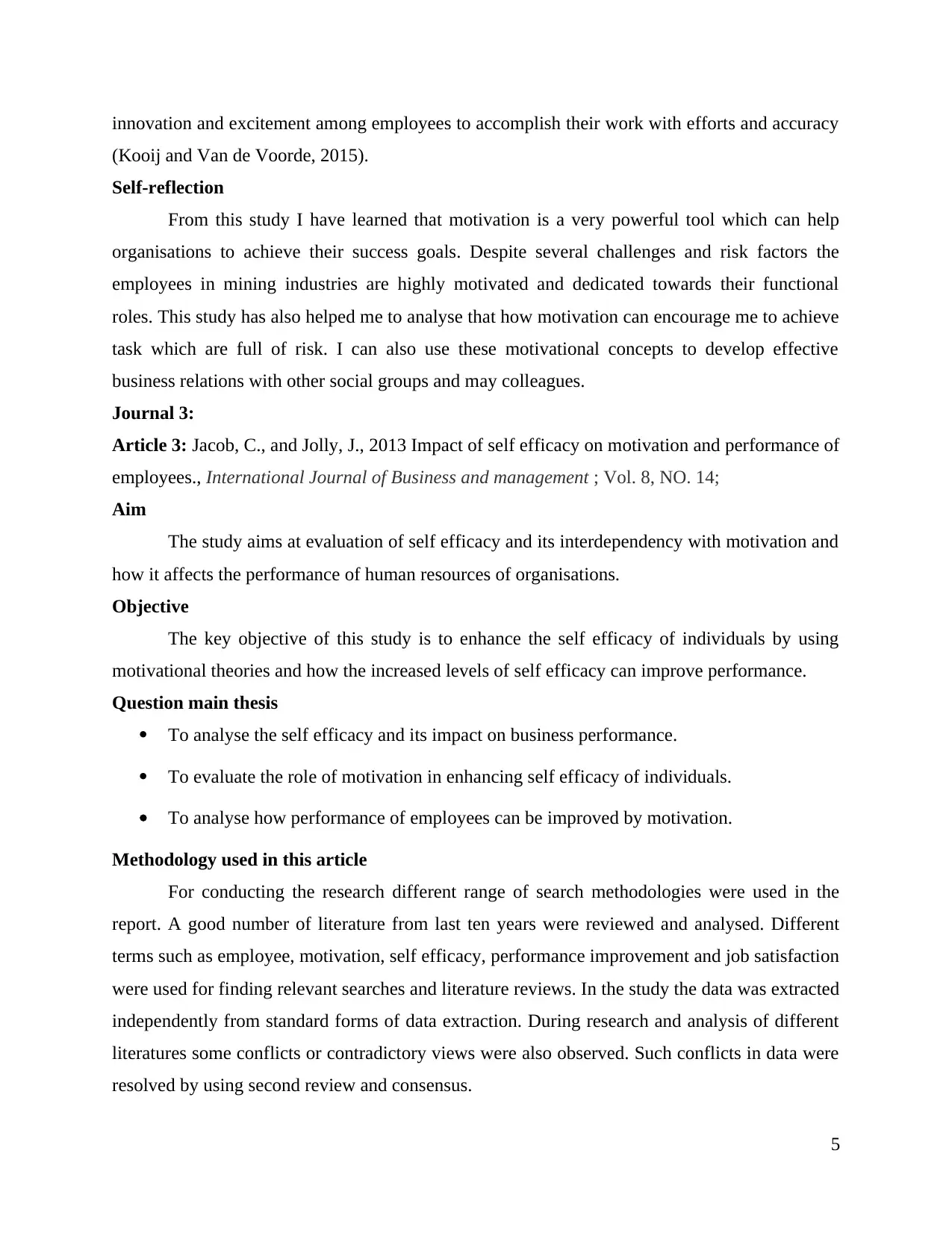
innovation and excitement among employees to accomplish their work with efforts and accuracy
(Kooij and Van de Voorde, 2015).
Self-reflection
From this study I have learned that motivation is a very powerful tool which can help
organisations to achieve their success goals. Despite several challenges and risk factors the
employees in mining industries are highly motivated and dedicated towards their functional
roles. This study has also helped me to analyse that how motivation can encourage me to achieve
task which are full of risk. I can also use these motivational concepts to develop effective
business relations with other social groups and may colleagues.
Journal 3:
Article 3: Jacob, C., and Jolly, J., 2013 Impact of self efficacy on motivation and performance of
employees., International Journal of Business and management ; Vol. 8, NO. 14;
Aim
The study aims at evaluation of self efficacy and its interdependency with motivation and
how it affects the performance of human resources of organisations.
Objective
The key objective of this study is to enhance the self efficacy of individuals by using
motivational theories and how the increased levels of self efficacy can improve performance.
Question main thesis
To analyse the self efficacy and its impact on business performance.
To evaluate the role of motivation in enhancing self efficacy of individuals.
To analyse how performance of employees can be improved by motivation.
Methodology used in this article
For conducting the research different range of search methodologies were used in the
report. A good number of literature from last ten years were reviewed and analysed. Different
terms such as employee, motivation, self efficacy, performance improvement and job satisfaction
were used for finding relevant searches and literature reviews. In the study the data was extracted
independently from standard forms of data extraction. During research and analysis of different
literatures some conflicts or contradictory views were also observed. Such conflicts in data were
resolved by using second review and consensus.
5
(Kooij and Van de Voorde, 2015).
Self-reflection
From this study I have learned that motivation is a very powerful tool which can help
organisations to achieve their success goals. Despite several challenges and risk factors the
employees in mining industries are highly motivated and dedicated towards their functional
roles. This study has also helped me to analyse that how motivation can encourage me to achieve
task which are full of risk. I can also use these motivational concepts to develop effective
business relations with other social groups and may colleagues.
Journal 3:
Article 3: Jacob, C., and Jolly, J., 2013 Impact of self efficacy on motivation and performance of
employees., International Journal of Business and management ; Vol. 8, NO. 14;
Aim
The study aims at evaluation of self efficacy and its interdependency with motivation and
how it affects the performance of human resources of organisations.
Objective
The key objective of this study is to enhance the self efficacy of individuals by using
motivational theories and how the increased levels of self efficacy can improve performance.
Question main thesis
To analyse the self efficacy and its impact on business performance.
To evaluate the role of motivation in enhancing self efficacy of individuals.
To analyse how performance of employees can be improved by motivation.
Methodology used in this article
For conducting the research different range of search methodologies were used in the
report. A good number of literature from last ten years were reviewed and analysed. Different
terms such as employee, motivation, self efficacy, performance improvement and job satisfaction
were used for finding relevant searches and literature reviews. In the study the data was extracted
independently from standard forms of data extraction. During research and analysis of different
literatures some conflicts or contradictory views were also observed. Such conflicts in data were
resolved by using second review and consensus.
5
Paraphrase This Document
Need a fresh take? Get an instant paraphrase of this document with our AI Paraphraser
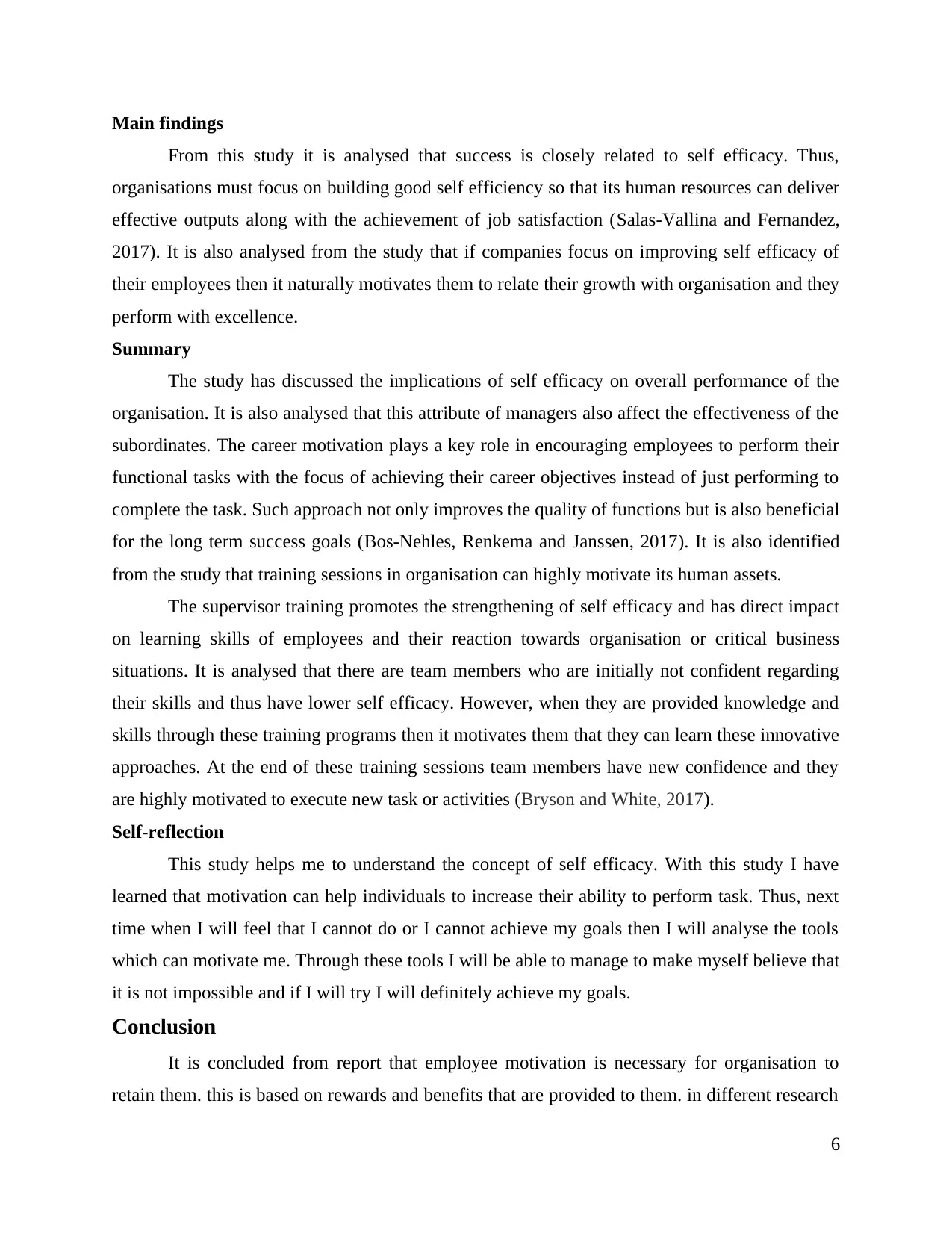
Main findings
From this study it is analysed that success is closely related to self efficacy. Thus,
organisations must focus on building good self efficiency so that its human resources can deliver
effective outputs along with the achievement of job satisfaction (Salas-Vallina and Fernandez,
2017). It is also analysed from the study that if companies focus on improving self efficacy of
their employees then it naturally motivates them to relate their growth with organisation and they
perform with excellence.
Summary
The study has discussed the implications of self efficacy on overall performance of the
organisation. It is also analysed that this attribute of managers also affect the effectiveness of the
subordinates. The career motivation plays a key role in encouraging employees to perform their
functional tasks with the focus of achieving their career objectives instead of just performing to
complete the task. Such approach not only improves the quality of functions but is also beneficial
for the long term success goals (Bos-Nehles, Renkema and Janssen, 2017). It is also identified
from the study that training sessions in organisation can highly motivate its human assets.
The supervisor training promotes the strengthening of self efficacy and has direct impact
on learning skills of employees and their reaction towards organisation or critical business
situations. It is analysed that there are team members who are initially not confident regarding
their skills and thus have lower self efficacy. However, when they are provided knowledge and
skills through these training programs then it motivates them that they can learn these innovative
approaches. At the end of these training sessions team members have new confidence and they
are highly motivated to execute new task or activities (Bryson and White, 2017).
Self-reflection
This study helps me to understand the concept of self efficacy. With this study I have
learned that motivation can help individuals to increase their ability to perform task. Thus, next
time when I will feel that I cannot do or I cannot achieve my goals then I will analyse the tools
which can motivate me. Through these tools I will be able to manage to make myself believe that
it is not impossible and if I will try I will definitely achieve my goals.
Conclusion
It is concluded from report that employee motivation is necessary for organisation to
retain them. this is based on rewards and benefits that are provided to them. in different research
6
From this study it is analysed that success is closely related to self efficacy. Thus,
organisations must focus on building good self efficiency so that its human resources can deliver
effective outputs along with the achievement of job satisfaction (Salas-Vallina and Fernandez,
2017). It is also analysed from the study that if companies focus on improving self efficacy of
their employees then it naturally motivates them to relate their growth with organisation and they
perform with excellence.
Summary
The study has discussed the implications of self efficacy on overall performance of the
organisation. It is also analysed that this attribute of managers also affect the effectiveness of the
subordinates. The career motivation plays a key role in encouraging employees to perform their
functional tasks with the focus of achieving their career objectives instead of just performing to
complete the task. Such approach not only improves the quality of functions but is also beneficial
for the long term success goals (Bos-Nehles, Renkema and Janssen, 2017). It is also identified
from the study that training sessions in organisation can highly motivate its human assets.
The supervisor training promotes the strengthening of self efficacy and has direct impact
on learning skills of employees and their reaction towards organisation or critical business
situations. It is analysed that there are team members who are initially not confident regarding
their skills and thus have lower self efficacy. However, when they are provided knowledge and
skills through these training programs then it motivates them that they can learn these innovative
approaches. At the end of these training sessions team members have new confidence and they
are highly motivated to execute new task or activities (Bryson and White, 2017).
Self-reflection
This study helps me to understand the concept of self efficacy. With this study I have
learned that motivation can help individuals to increase their ability to perform task. Thus, next
time when I will feel that I cannot do or I cannot achieve my goals then I will analyse the tools
which can motivate me. Through these tools I will be able to manage to make myself believe that
it is not impossible and if I will try I will definitely achieve my goals.
Conclusion
It is concluded from report that employee motivation is necessary for organisation to
retain them. this is based on rewards and benefits that are provided to them. in different research
6
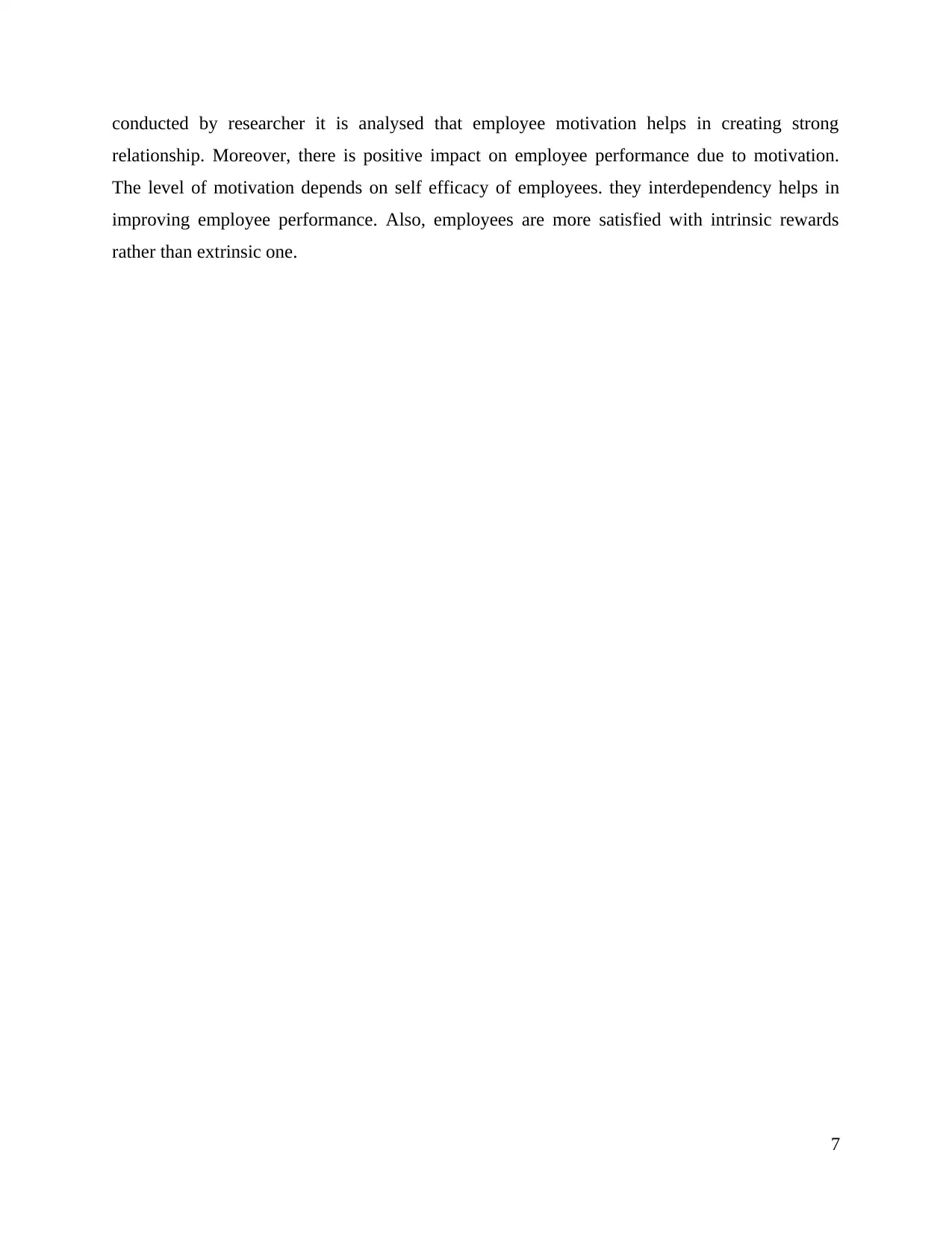
conducted by researcher it is analysed that employee motivation helps in creating strong
relationship. Moreover, there is positive impact on employee performance due to motivation.
The level of motivation depends on self efficacy of employees. they interdependency helps in
improving employee performance. Also, employees are more satisfied with intrinsic rewards
rather than extrinsic one.
7
relationship. Moreover, there is positive impact on employee performance due to motivation.
The level of motivation depends on self efficacy of employees. they interdependency helps in
improving employee performance. Also, employees are more satisfied with intrinsic rewards
rather than extrinsic one.
7
⊘ This is a preview!⊘
Do you want full access?
Subscribe today to unlock all pages.

Trusted by 1+ million students worldwide
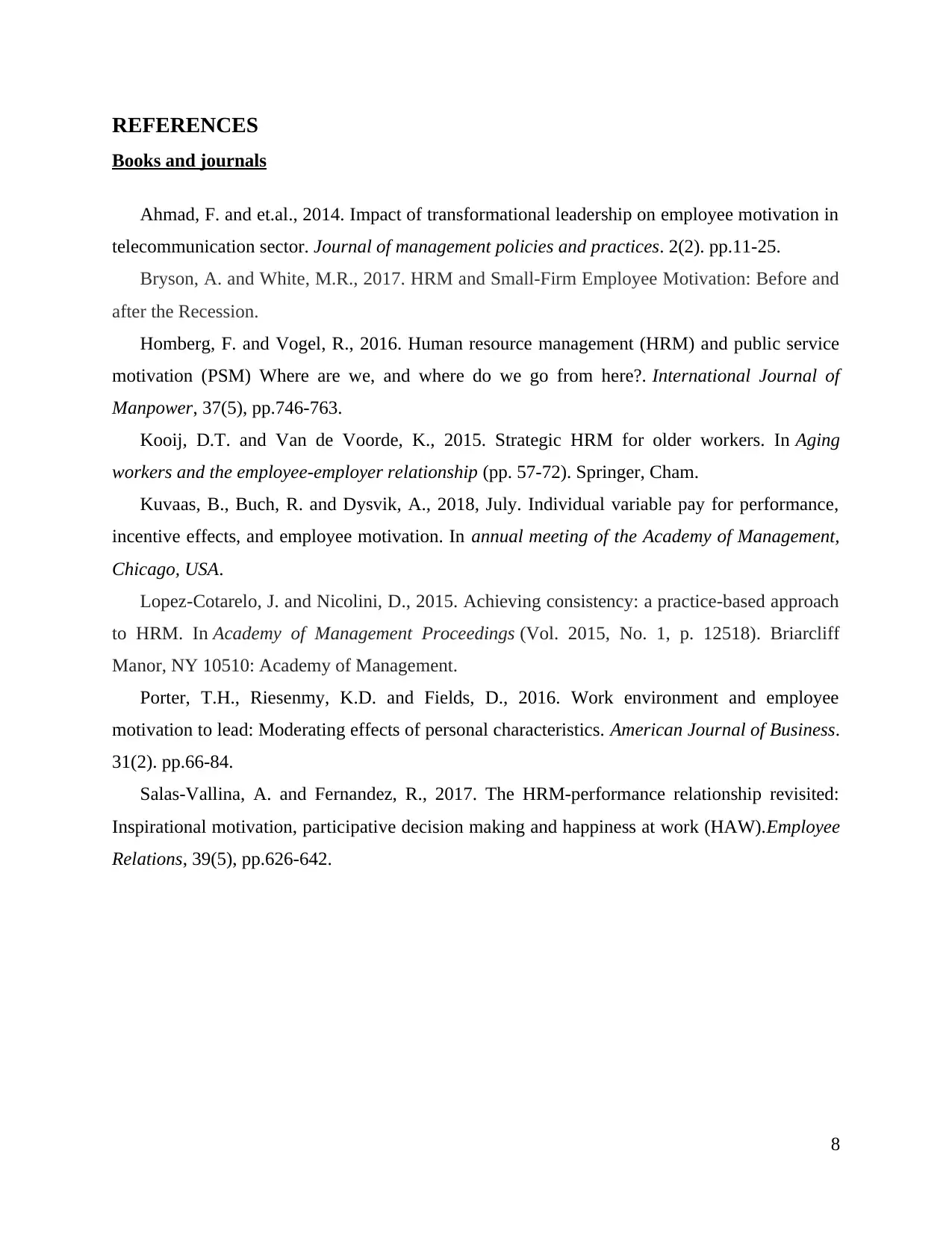
REFERENCES
Books and journals
Ahmad, F. and et.al., 2014. Impact of transformational leadership on employee motivation in
telecommunication sector. Journal of management policies and practices. 2(2). pp.11-25.
Bryson, A. and White, M.R., 2017. HRM and Small-Firm Employee Motivation: Before and
after the Recession.
Homberg, F. and Vogel, R., 2016. Human resource management (HRM) and public service
motivation (PSM) Where are we, and where do we go from here?. International Journal of
Manpower, 37(5), pp.746-763.
Kooij, D.T. and Van de Voorde, K., 2015. Strategic HRM for older workers. In Aging
workers and the employee-employer relationship (pp. 57-72). Springer, Cham.
Kuvaas, B., Buch, R. and Dysvik, A., 2018, July. Individual variable pay for performance,
incentive effects, and employee motivation. In annual meeting of the Academy of Management,
Chicago, USA.
Lopez-Cotarelo, J. and Nicolini, D., 2015. Achieving consistency: a practice-based approach
to HRM. In Academy of Management Proceedings (Vol. 2015, No. 1, p. 12518). Briarcliff
Manor, NY 10510: Academy of Management.
Porter, T.H., Riesenmy, K.D. and Fields, D., 2016. Work environment and employee
motivation to lead: Moderating effects of personal characteristics. American Journal of Business.
31(2). pp.66-84.
Salas-Vallina, A. and Fernandez, R., 2017. The HRM-performance relationship revisited:
Inspirational motivation, participative decision making and happiness at work (HAW).Employee
Relations, 39(5), pp.626-642.
8
Books and journals
Ahmad, F. and et.al., 2014. Impact of transformational leadership on employee motivation in
telecommunication sector. Journal of management policies and practices. 2(2). pp.11-25.
Bryson, A. and White, M.R., 2017. HRM and Small-Firm Employee Motivation: Before and
after the Recession.
Homberg, F. and Vogel, R., 2016. Human resource management (HRM) and public service
motivation (PSM) Where are we, and where do we go from here?. International Journal of
Manpower, 37(5), pp.746-763.
Kooij, D.T. and Van de Voorde, K., 2015. Strategic HRM for older workers. In Aging
workers and the employee-employer relationship (pp. 57-72). Springer, Cham.
Kuvaas, B., Buch, R. and Dysvik, A., 2018, July. Individual variable pay for performance,
incentive effects, and employee motivation. In annual meeting of the Academy of Management,
Chicago, USA.
Lopez-Cotarelo, J. and Nicolini, D., 2015. Achieving consistency: a practice-based approach
to HRM. In Academy of Management Proceedings (Vol. 2015, No. 1, p. 12518). Briarcliff
Manor, NY 10510: Academy of Management.
Porter, T.H., Riesenmy, K.D. and Fields, D., 2016. Work environment and employee
motivation to lead: Moderating effects of personal characteristics. American Journal of Business.
31(2). pp.66-84.
Salas-Vallina, A. and Fernandez, R., 2017. The HRM-performance relationship revisited:
Inspirational motivation, participative decision making and happiness at work (HAW).Employee
Relations, 39(5), pp.626-642.
8
Paraphrase This Document
Need a fresh take? Get an instant paraphrase of this document with our AI Paraphraser

9

1
⊘ This is a preview!⊘
Do you want full access?
Subscribe today to unlock all pages.

Trusted by 1+ million students worldwide
1 out of 12
Related Documents
Your All-in-One AI-Powered Toolkit for Academic Success.
+13062052269
info@desklib.com
Available 24*7 on WhatsApp / Email
![[object Object]](/_next/static/media/star-bottom.7253800d.svg)
Unlock your academic potential
Copyright © 2020–2025 A2Z Services. All Rights Reserved. Developed and managed by ZUCOL.





